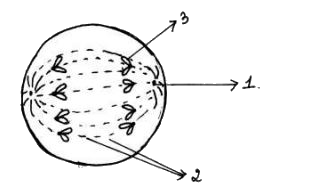The diagram represents gametes P and Q fusing to give cell R. This cell then produces gametes S.T.U and V.

(i) State whether P, Q and Rare Haploid or diploid.
(ii) What is the Ratio of Number of Chromosomes in a Human Zygote and a Human Sperm?
(iii) The parental cell divides and gives rise to two daughter cells. Each division doubles the number of cells. How many numbers of cells will be there in third generation? If starting cells is considered as 0 generation.
Text Solution
(i) P and Q are haploid gametes while R is zygote and diploid.
(ii) The number of chromosomes in a human sperm is half the number of chromosomes in a zygote i.e their ratio is 2:1
(iii) The number of cells increases exponentially and can be expressed as 2n, where n is the number of generations. If we apply the formula 2n, where n is equal to 3, the single cell would give rise to 23 i.e 8 cells.
|
Updated on:21/07/2023
Topper's Solved these Questions
- BOOK - OSWAL PUBLICATIONCHAPTER - HOW DO ORGANISMS REPRODUCE ?EXERCISE - APPLICATION BASED QUESTIONS13videos
HOW DO ORGANISMS REPRODUCE ?
- BOOK - OSWAL PUBLICATIONCHAPTER - HEREDITY AND EVOLUTION EXERCISE - CREATING BASED QUESTIONS11videos
HEREDITY AND EVOLUTION
- BOOK - OSWAL PUBLICATIONCHAPTER - LIFE PROCESSESEXERCISE - BOARD CORNER (LONG ANSWER TYPE QUESTIONS)2videos
LIFE PROCESSES
Similar Questions
Knowledge Check
- Question 1 - Select One
The number of chromosomes are present in human cell
a) 22 pairs
b) 23 pairs
c) 24 pairs
d) 26 pairsA22 pairsB23 pairsC24 pairsD26 pairs - Question 2 - Select One
The two daughter cells produced at the end of meiosis I when compared to the parent diploid cell will have:
Asame amount of DNA and same number of chromosomes.Bsame amount of DNA and half number of chromosomes.Chalf amount of DNA and half number of chromosomes.Dhalf amount of DNA and same number of chromosomes. - Question 3 - Select One
A cell division in which a diploid somatic cell divides into two identical daughter cells is called
AMeiosis IBMeiosis IICMitosisDCytokinesis
Chromosome number of the parent is conserved in the daughter cells in
View SolutionChromosome number of the parent is conserved in the daughter cells in
View SolutionIn which type of cell division, chromosome number becomes halved in daughter cells?
View SolutionThe diagram given below represents a stage during mitotic cell division in an animal cell:-

What is the chromosome number of the cell?View SolutionIn diploid organisms gamete mother cells produce gametes. They are called
View Solution

